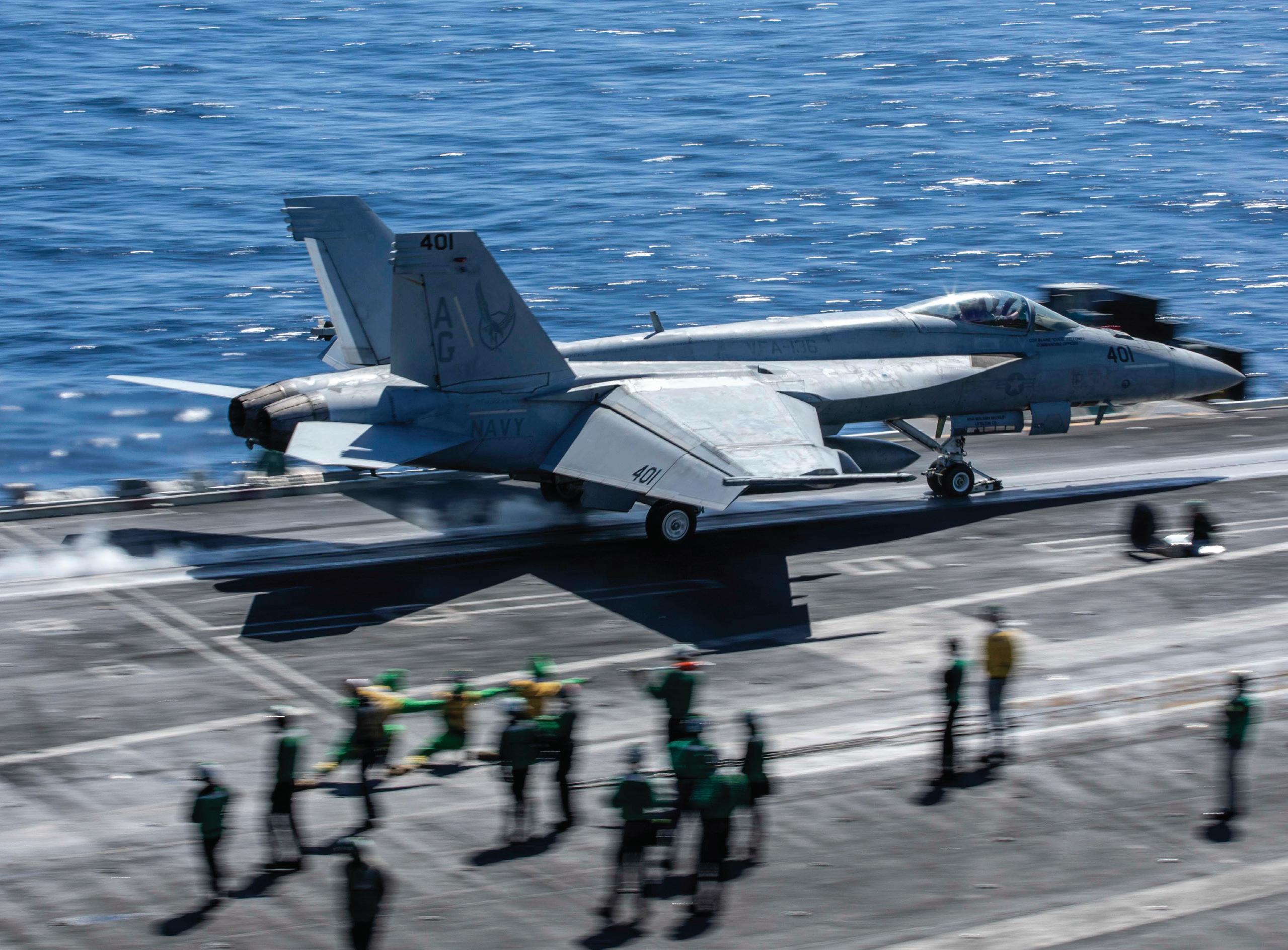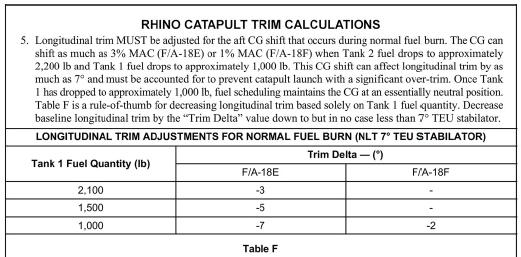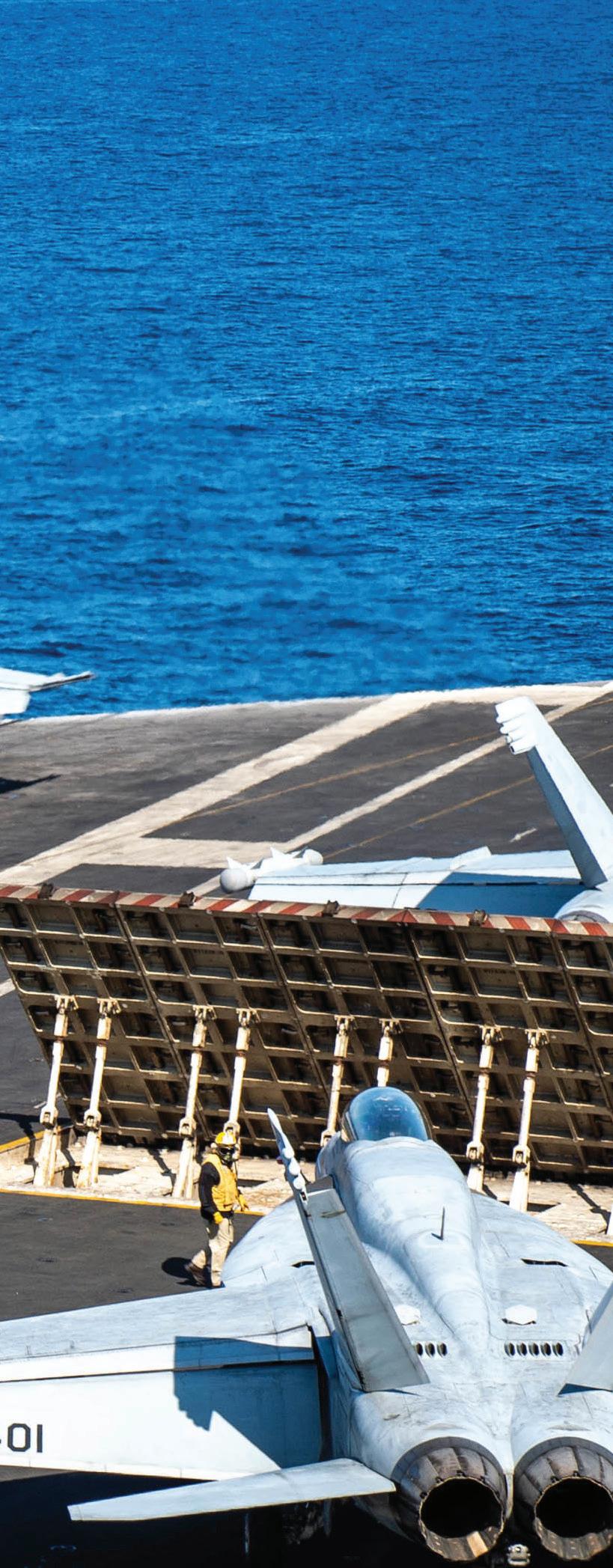
7 minute read
5-Wet Catapult Shots: A Renewed Understanding
By Lt. Cmdr. Mark Van Orden, VFA-103
Duringa Tailored Ship’s Training Availability (TSTA) in February and March of 2022, members of the CVW-7 tanking cadre found themselves experiencing less-thandesirable 5-wet tanker catapult shots. Although the majority of the team hadn’t been to sea in at least a couple of years, several experienced pilots, including department heads and squadron commanders, noted fly-away profiles that seemed different than previously experienced. After extensive research and coordination with the VX-23 Carrier Suitability Team and NAS Lakehurst catapult professionals, we determined the causes of these less-than-desirable flyaway profiles were due to several factors: high natural wind over the deck, MORIAH sensor assignment and tanker trim settings. Several important lessons were learned and VFA-103 has subsequently instituted renewed tanker trim settings that have proved beneficial.
Most of the catapult shots in question were first noticed due to a flat flyaway profile. Several tanker pilots noted the waterline symbol immediately shot up to 10-12 degrees with a full slow chevron. It took two to four seconds for the angle of attack (AOA) bracket to catch up to the velocity vector and the same amount of time for a positive rate of climb to be established. Thankfully, there was never a negative vertical speed indicator (VSI) postlaunch. After several aircrew noticed the aggressive initial flyaway, a study of memory unit (MU) data began, along with coordination with the gurus mentioned above.
The first issue the Carrier Suitability Team noted was high natural wind over the deck (WOD). Throughout TSTA, the carrier routinely experienced high wild wind days, often over 30 knots, while the ship made minimal speed through the water. A bow burble is created when the carrier experiences high WOD, especially natural wind. All carrier aircrew are familiar with the burble created by the tower structure during landing operations. Still, the burble created upon launch is rarely discussed and arguably not widely understood. When there is high WOD, the bow burble creates a pocket of unstable air right in front of the bow. The bow burble will typically begin forming around 20-25 knots and build in size as WOD increases. It shrinks with the bow moving up and expands in size with the bow moving down. Simply put, the higher the WOD, the larger the burble effect can be. Therefore, if the air mass directly at the end of the stroke is unstable or slower than what the launch was calculated for, you could have a flatter flight profile or have a couple of feet of settle.
Although there is no way to avoid this, aircrews and shooters should be aware of high WOD days and how it could subsequently affect launches. The bow burble effects will likely not be seen with a single centerline fighter-configured aircraft that jumps off the deck. However, 5-wet tanker aircrew should be prepared for a flatter flight profile or a slight settle on high WOD days. Rest assured; the MIN+15 knot endspeed that shooters calculate should ultimately account for this.
The second major lesson from this experience surrounded the importance of MORIAH and its associated settings. MORIAH is the wind-sensing system aboard all aircraft carriers and normally takes wind readings via three Wind Sensor Units (WSU) arranged in different spots on the carrier deck: Port (PORT), Starboard (STBD) and Forward (FWD). Each sensor has a specific angle range at which it is designed to capture the most accurate wind. The FWD has an angle range of 315-45 degrees, STBD 46 to 180 degrees and PORT 181 to 314 degrees. The following is taken directly from Landing Signal Officer (LSO) NATOPS, July 30, 2021, pages 4-17:
“In AUTO mode, MORIAH selects the windward-most sensor thereby achieving the most non-turbulent wind measurements. In MANUAL mode, the operator manually selects either the PORT, STBD, or FWD WSU from which to obtain wind measurements. Manual WSU selection and selection between MANUAL and AUTO can only be accomplished on the Flight Critical High End Display (FCHED) located in PriFly.”
Most importantly, a warning follows this paragraph which states: ship was likely not receiving the most accurate wind data for launches and recoveries. In emails with the Carrier Suitability Team, they further explained that by always using the STBD wind sensor, the potential for the wind data not reflecting the wind at the deck level is a concern and could lead to a cat setting for a higher WOD than the aircraft is seeing. Would it be grossly off? Not likely. But it could be off just enough to see a slightly flatter flight profile off the cat stroke.
Further discussions with the ship revealed the STBD sensor was the only sensor that was working during that time. Post TSTA, George H.W. Bush did an excellent job acquiring the necessary equipment to allow MORIAH to function in the AUTO mode. All carriers and their respective air departments should take the steps needed to ensure MORIAH is working correctly, using all three sensors, before any underway period.
The third and arguably most crucial finding during our research involved the proper trim settings on 5-wet tankers. In true aviator fashion, we love to live and die by the gouge. The gouge has always been that a trim setting of about 10 worked for most 5-wet tankers. However, a closer analysis of NATOPS reveals 10 degrees is likely too much trim. Turning to pages 8.2-5 of the Big Book (NATOPS A1-EFG18-NFM-000), we can walk through the Rhino catapult trim calculations.
In steps 1 and 2, the standard assumption or gouge is that we will launch at 66k with 0 asymmetry, requiring max power.
Throughout TSTA, CVW-7 LSOs noted issues regarding the accuracy of the wind data in both direction and speed. Discussions with CAG paddles (LSOs) post detachment revealed USS George H.W. Bush had operated exclusively in the STBD mode of operation throughout the underway. Therefore, the
In Step 3, referencing Table B, we determine our catapult launch endspeed. It is important to note here that the lines from 61k to 66.8k are separated individually. One must pay special attention to the fact that launching at 66k, which would likely only occur with a fully fueled 5-wet taxiing to the cat immediately post fueling, has a 161-knot endspeed, while a 64k or 65k endspeed is actually 160. This invalidates our previous assumption of launching at 66k and is a mere precursor to the next step.
Continued on Page 42»

In Step 4, we now determine the required baseline longitudinal trim. This step introduced a vital learning point during our analysis and discussions with the Carrier Suitability Team.


Not long after our inquiries, a squadron commander from CVW-8, embarked on USS Gerald R. Ford, reached out to the team with concerns that almost directly mirrored ours: seasoned tanker pilots experiencing less-than-desirable cat shots. After his initial review, he determined unrealistic FormFs promoted a higher trim setting than required. He then instructed his squadron to use 7 degrees nose up for 64k and 8 degrees nose up for 65k+. These much smaller trim settings were surprising compared to the historical gouge many were used to.

Upon further analysis, we realized that our Form-Fs were calculated using only a 300-pound fuel burn for start, taxi and takeoff. That is unrealistic in the carrier environment. Therefore, we adjusted the fuel burn to a more realistic number of around 1,000 pounds and began a study of what the average center of gravity (CG) the Form-F would then produce.
On average, a 5-wet foxtrot will have a CG of between 21% and 22% when adjusted appropriately for the fuel burn on deck. Therefore, a 65k shot with a 160-knot endspeed and 22% CG would produce a trim setting of 8 degrees nose up.
Step 5 is unquestionably the most revealing step that is widely misunderstood or unknown throughout the fleet.
This step is again the most important information I can submit to the fleet in this article. Upon reviewing and incorporating this step, VFA-103 has seen a marked improvement in fly away characteristics of the 5-wet tankers. Looking at our Form-Fs, we have established a baseline trim setting across all our tankers whose CG’s are relatively similar. As a general rule of thumb, 66k will require 9 degrees nose up, 65k 8 degrees nose up and ≤ 64k 7 degrees nose up. However, the 1000-pound Tank 1 caveat always exists.
While our experiences on TSTA were a combination of the three primary factors mentioned above, they allowed us to learn a lot more about the 5-wet in the carrier environment. Most notably, tanker aircrew should expect potentially flatter fly away characteristics due to the Bow Burble if the WOD is high, especially when combined with a pitching deck. Secondly, carrier air departments should ensure MORIAH is always functioning properly in AUTO mode. Finally, tanker aircrew must diligently calculate their trim setting and adjust for on-deck fuel burn.
Longitudinal trim must be adjusted for the aft CG shift during normal fuel burn on deck. Following Step 5, aircrew must adjust their longitudinal trim by noting their Tank 1 fuel quantity and must adjust differently for an echo and foxtrot. However, you will NEVER trim less than 7 degrees. This step essentially considers what we were doing by adjusting to a more realistic fuel burn on our Form-F’s.

We wrote this article to give the fleet a better understanding to hopefully provide smooth 5-wet cat shots that won’t scare anyone as they launch into the dark abyss to do our nation’s bidding overhead at 6,000, 8,000 and 10,000 feet.
A huge thank you goes out to all the specialists answering our seemingly elementary questions. A special thank you to the Carrier Suitability Team onboard NAS Patuxent River, Maryland, especially Jacques Romano and Charles Trost. Also, a thank you to the air department aboard George H.W. Bush for handling our constant inquiries and their catapult shot data compilation.
Want to be Featured in Approach?
Submission Guidelines
Please use the following guidelines when submitting articles and BZ nominations for Approach Magazine.
If you have already written your article and are familiar with our magazines, simply email the address below:
SAFE-Approach@navy.mil
Length
Short story: 800-1,500 words
Feature story: 2,500-3,000 words
News briefs: 500 words
BZ nominations: 90-150 words
Fact-checking
We ask that writers research reference materials, such as manuals and books used in their articles. Please verify your sources before attributing quotes to them. If you need us to conduct additional factchecking, please make a note of it when submitting your article or BZ nomination.
Photos
All photos must be high resolution (a minimum of 300 dpi) in JPEG or JPG format. Please ensure the photographer (include first and last name and rank if applicable) or source is credited in your article submission.
When you email your article or BZ nomination, use the author’s last name and first initial as the file name. For example: Lastname-F.doc.
We look forward to receiving your submissions!
Front Cover
U.S. Air Force photo by Staff Sgt. Noah D. Coger dvidshub.net - 7628258
Back Cover
U.S. Navy photo by Mass Communication Specialist 1st Class Bobby Bladock dvidshub.net - 7646853
Our cover features a hidden raven. Can you find it?

